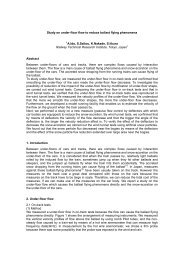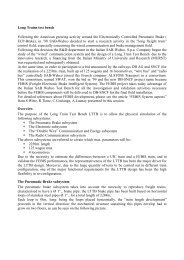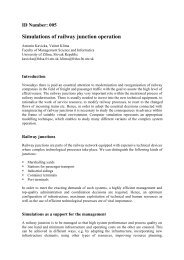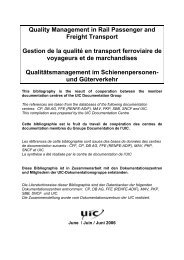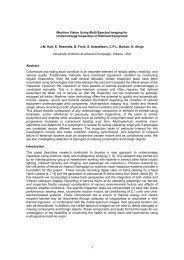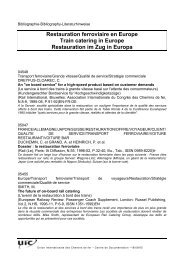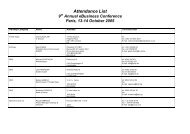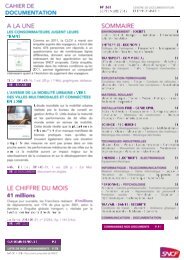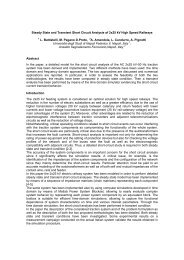Measurement of Line Characteristics and of Track Irregularities ... - UIC
Measurement of Line Characteristics and of Track Irregularities ... - UIC
Measurement of Line Characteristics and of Track Irregularities ... - UIC
You also want an ePaper? Increase the reach of your titles
YUMPU automatically turns print PDFs into web optimized ePapers that Google loves.
World Congress on Railway Research, Köln<br />
November 2001<br />
Special Poster Presentation (SP) “Technical Diagnosis”<br />
<strong>Measurement</strong> <strong>of</strong> <strong>Line</strong> <strong>Characteristics</strong> <strong>and</strong> <strong>of</strong> <strong>Track</strong> <strong>Irregularities</strong><br />
by Means <strong>of</strong> DGPS <strong>and</strong> INS<br />
SUMMARY<br />
Dipl.-Ing. Thorsten Lück, IFEN Neubiberg<br />
Pr<strong>of</strong>. Dr.-Ing. Peter Meinke, C+K GmbH Starnberg<br />
Pr<strong>of</strong>. Dr.-Ing. Bernd Eisfeller, IFEN Neubiberg<br />
Dipl.-Ing. Christian Kreye, IFEN Neubiberg<br />
Dipl.-Ing. Johannes Stephanides, ÖBB Wien<br />
Dipl.-Ing. Laszlo Tordai, ERRI Utrecht<br />
The knowledge <strong>of</strong> geometric track irregularities is important for dynamic safety <strong>of</strong><br />
railways. It becomes evident with rising use <strong>of</strong> tilting trains, as irregularities may lead<br />
to train derailment. Especially to identify isolated track defects, a new measuring technique<br />
using differential GPS <strong>and</strong> an inertial navigation system to determine the position<br />
<strong>of</strong> the track measuring system was developed.<br />
The goal is to measure long wavelength track irregularity up to 150 m wavelength<br />
within mm accuracy. The length <strong>of</strong> the track segment under surveillance is assumed 40<br />
km ( 20 km) <strong>and</strong> the intended measuring speed is 30 - 50 km/h with approximately<br />
15 cm data point spacing on the track.<br />
This report discusses the system design <strong>and</strong> integration technique <strong>and</strong> presents experimental<br />
results from the prototype measurement vehicle. Also critical aspects <strong>of</strong><br />
high-precision DGPS/INS integration are outlined.<br />
1 OVERALL SYSTEM<br />
It is the task <strong>of</strong> the <strong>Track</strong> Irregularity <strong>Measurement</strong> System to provide highly accurate<br />
positioning data for both <strong>of</strong> the railheads. From the instrumental conditions <strong>and</strong><br />
operational requirements the following parameters for the <strong>Track</strong> Irregularity <strong>Measurement</strong><br />
System were defined:<br />
(1) General parameters:<br />
<strong>Measurement</strong> Segment 20 km (equals 40 km)<br />
Data point spacing d = 20 cm<br />
<strong>Measurement</strong> speed v = 30 – 50 km/h
(2) Navigation <strong>and</strong> positioning system requirements:<br />
Horizontal position 1 mm<br />
Vertical position 1 mm<br />
The system design is based on the integration <strong>of</strong> Differential GPS (DGPS) with an Inertial<br />
Navigation System (INS) for positioning. The primary task <strong>of</strong> the system is to<br />
acquire high-precision data for post-processing.<br />
Using ultrasonic sensors, in addition the horizontal <strong>and</strong> vertical distances between the<br />
platform <strong>and</strong> the railheads is determined. From this, with the knowledge <strong>of</strong> the absolute<br />
position <strong>of</strong> the platform, the absolute geodetic position <strong>of</strong> the railheads can be derived.<br />
1.1 Positioning <strong>of</strong> measurement platform<br />
The platform positioning system consists <strong>of</strong> three basic sub-systems:<br />
Platform measurement equipment to be mounted on a draisine (Figure 1),<br />
containing<br />
Sensor subsystem<br />
Data acquisition <strong>and</strong> archiving system<br />
Time synchronization module<br />
DGPS reference station<br />
Off-line processing system<br />
Figure 1: <strong>Measurement</strong> Vehicle <strong>of</strong> the Austrian railways (ÖBB) with upset measurement<br />
platform
The sensor subsystem consists <strong>of</strong> both the positioning system to determine the absolute<br />
position <strong>of</strong> the platform <strong>and</strong> the distance measurement system to determine the<br />
position <strong>of</strong> the railheads relative to the platform.<br />
To determine the higher dynamics <strong>of</strong> the platform, a precise inertial navigation system<br />
is used. The INS position is then augmented using carrier phase positions <strong>of</strong> the differential<br />
GPS system to eliminate inertial errors.<br />
Figure 2 shows the block diagram <strong>of</strong> the measurement system.<br />
Figure 2: Block diagram <strong>of</strong> platform measurement system<br />
Figure 3: Principal <strong>of</strong> track geometry <strong>and</strong> irregularity measurements
1.2 <strong>Measurement</strong> <strong>of</strong> the railheads<br />
Surveying <strong>of</strong> the railheads is done by use <strong>of</strong> ultrasonic sensors in two perpendicular directions.<br />
The distance between platform <strong>and</strong> railheads is measured in horizontal <strong>and</strong><br />
vertical direction. Considering the attitude <strong>and</strong> position <strong>of</strong> the platform determined by<br />
the positioning system, the absolute position <strong>of</strong> both railheads could be derived.<br />
Figure 4: Definition <strong>of</strong> track irregularity parameters<br />
To determine the track defects, the track parameters in accordance to Figure 4 are determined<br />
<strong>and</strong> are investigated for specific defects e.g. by means <strong>of</strong> wavelet analysis.<br />
2 HARDWARE COMPONENTS<br />
The system to determine the inertial position (positioning system) uses the following<br />
hardware components:<br />
Inertial Navigation System (INS)<br />
GPS L1/L2 receiver<br />
Choke-Ring Antenna<br />
Multiport Serial Card<br />
Event timer<br />
Dual-Pentium personal computer<br />
For the reference station the following hardware components are used:<br />
GPS L1/L2 receiver<br />
Choke-Ring Antenna<br />
Pentium personal computer
2.1 Synchronization<br />
The timing board is triggered with the 1 PPS output <strong>of</strong> the GPS receiver, which is synchronized<br />
to GPS time. The INS uses it's own time base but provides a trigger signal<br />
for each message it sends to the serial port on a 100Hz basis for raw inertial data <strong>and</strong><br />
on a 50Hz basis for navigation data. These trigger signals are time-tagged by the<br />
event-timing card <strong>and</strong> are read from the navigation s<strong>of</strong>tware nearly in real time.<br />
2.2 GPS Receiver<br />
The GPS receiver provides dual frequency GPS performance. Featuring Narrow Correlator<br />
<strong>and</strong> P-code Delayed Correlation Technologies, the receiver outputs pseudorange<br />
<strong>and</strong> full wavelength carrier phase observations for both L1 <strong>and</strong> L2 frequencies.<br />
It provides two serial data channels, assigned as COM 1 <strong>and</strong> COM 2. Both channels<br />
can be used for data logging <strong>and</strong> receiver programming. Real pseudorange <strong>and</strong><br />
carrier phase are provided at up to 4Hz. Table 1 provides the specifications <strong>of</strong> the receiver.<br />
Features<br />
mm level post-processed accuracy<br />
L1-C/A code <strong>and</strong> carrier tracking<br />
L2-P code <strong>and</strong> carrier tracking<br />
4 Hz position output rate<br />
4 Hz raw data output rate (Pseudorange)<br />
Specifications<br />
Position accuracy<br />
St<strong>and</strong> alone<br />
SA <strong>of</strong>f 15m CEP<br />
SA on 40m CEP<br />
Differential<br />
Code (L1, C/A) 0.75m<br />
<strong>Measurement</strong> precision<br />
L1 carrier phase<br />
Single channel 3mm RMS<br />
Differential channel 0.75mm RMS<br />
Dynamics<br />
Acceleration 6g<br />
Velocity 515m/s<br />
Table 1: Specification <strong>of</strong> GPS-receiver<br />
The GPS data (pseudoranges <strong>and</strong> doppler velocity) is captured during mission <strong>and</strong><br />
processed in <strong>of</strong>fline mode (post processing). For data analysis <strong>and</strong> processing, several<br />
s<strong>of</strong>tware packages are applicable, PHARAO (Phase Ambiguity Resolution On-The-<br />
Fly), which is a high-precision DGPS/DGLONASS/DAPL navigation system that has<br />
been developed over the last few years at the institute (IfEN) <strong>and</strong> GeoGenius from<br />
Terrasat.
To suppress multipath errors, the antenna <strong>of</strong> the reference station as well as the rover<br />
antenna is equipped with a choke ring. To minimize effects due to shadowing <strong>and</strong><br />
multipath on the draisine, the antenna is build up on a mast so that the antenna phase<br />
center is above the vehicle’s ro<strong>of</strong>.<br />
2.3 Inertial Navigation System (INS)<br />
To measure the higher dynamics <strong>of</strong> the measurement platform, a so-called strapdown<br />
INS is used. This systems uses ring laser gyros to determine the rotation angel. Table 2<br />
shows some technical data <strong>of</strong> the used system.<br />
Performance<br />
Position<br />
Altitude<br />
Azimuth<br />
Pitch <strong>and</strong> Roll<br />
<strong>Characteristics</strong><br />
Size<br />
Weight<br />
Power requirements<br />
Cooling<br />
Periodic calibration<br />
Operating conditions<br />
Latitude range<br />
Temperature<br />
Vibrations<br />
Shock<br />
Environment<br />
To avoid unsteady position solutions <strong>of</strong> the INS, the ZUPT mode can be deactivated<br />
after the initial alignment.<br />
Figure 5: Strapdown INS together with GPS choke ring antenna. This right figure shows<br />
the left sided lever arm <strong>of</strong> the measurement platform with two ultrasonic sensors to<br />
measure the vertical <strong>and</strong> horizontal distance to the rail head.<br />
2.4 Ultrasonic Distance <strong>Measurement</strong> Unit<br />
To measure the distance between the platforms lever arms <strong>and</strong> the railheads, four ultrasonic<br />
sensors are used. They measure the horizontal <strong>and</strong> vertical distance on both<br />
sides <strong>of</strong> the rail. <strong>Measurement</strong>s are synchronous to the inertial measurements <strong>and</strong> are<br />
triggered by the INS 100Hz synchronization signal.<br />
Using a switch, the trigger signal can be applied to the sensors by the operator. The<br />
timing card determines the time when the switch is used. Thus a precise correlation to<br />
the inertial measurement data is possible. Figure 5 shows one lever arm <strong>and</strong> the corresponding<br />
ultrasonic sensors. The horizontal distance is measured from the inner side to<br />
the railhead.
3 KALMAN FILTER DESIGN<br />
To integrate INS <strong>and</strong> DGPS measurements, a KALMAN filter is used. This optimal<br />
filter estimates the systematical errors <strong>of</strong> the inertial system due to precise DGPS observations<br />
<strong>and</strong> thus can correct for these errors to calculate the absolute position, attitude<br />
<strong>and</strong> velocity.<br />
Integration <strong>of</strong> GPS <strong>and</strong> INS can be done on different levels (so called loose, tight <strong>and</strong><br />
deeply coupling).<br />
The system specification requires a resolution on the track <strong>of</strong> about 20 cm. At measurement<br />
speed <strong>of</strong> 30km/h this leads to a position rate <strong>of</strong> at least 42 Hz. As the INS delivers<br />
navigational information at a 50Hz data rate, loose coupling is feasible.<br />
As a basis for the KALMAN Filter, the filter concept first described by Schmidt is<br />
used, which models the basic dynamic errors <strong>of</strong> a free inertial system. Adding other<br />
states derived from the error analysis <strong>of</strong> the INS then augments this system. As the<br />
used INS is <strong>of</strong> high precision, only biases <strong>of</strong> the accelerometers <strong>and</strong> gyros are used to<br />
augment the KALMAN filter whereas scale factor errors are neglected.<br />
3.1 State Vector<br />
The state vector <strong>of</strong> the filter consists <strong>of</strong> the following 27 elements:<br />
X äÈ , äv,<br />
är,<br />
d,<br />
b<br />
INS/GPS<br />
The first nine states represent the INS navigation errors:<br />
Vector <strong>of</strong> attitude error with respect to north, east <strong>and</strong> down axes<br />
v Vector <strong>of</strong> velocity error in latitude rate, longitude rate <strong>and</strong> altitude rate<br />
r Vector <strong>of</strong> position error in latitude, longitude <strong>and</strong> altitude<br />
The next 15 states result from the error analysis <strong>and</strong> express the major INS sensor error<br />
sources:<br />
d Vector <strong>of</strong> uncompensated gyro drift<br />
b Vector <strong>of</strong> uncompensated accelerometer bias<br />
3.2 Dynamic Coupling <strong>and</strong> State transition<br />
Dynamic coupling between states is expressed by the dynamic matrix F with white<br />
process noise input:<br />
x<br />
F<br />
The transition matrix, necessary for prediction <strong>of</strong> states <strong>and</strong> covariance is obtained by<br />
x<br />
w
Ö<br />
I<br />
F<br />
1<br />
t F<br />
2<br />
The dynamic matrix F is shown below, with brief explanation <strong>of</strong> the sub matrices following:<br />
F<br />
0<br />
0<br />
FFree<br />
[ 9x9]<br />
0<br />
0<br />
0<br />
0<br />
The sub matrix F free is taken from Schmidt (1978) <strong>and</strong> is not shown in detail here.<br />
C<br />
n<br />
b<br />
0<br />
0<br />
I<br />
0<br />
g<br />
2<br />
I<br />
0<br />
t<br />
DC<br />
Correlation coefficients <strong>of</strong> gyros (index g) <strong>and</strong> accelerometers (index a)<br />
I 3x3 unit matrix<br />
n<br />
The C b Matrix is the transformation matrix between body <strong>and</strong> navigation frame <strong>and</strong> is<br />
defined as<br />
with<br />
Roll<br />
Pitch<br />
n<br />
Cb<br />
Azimuth.<br />
cos<br />
cos<br />
sin<br />
cos<br />
sin<br />
cos<br />
sin<br />
sin cos<br />
sin sin sin<br />
cos cos<br />
cos sin<br />
sin<br />
0<br />
0<br />
2<br />
n<br />
b<br />
a<br />
cos<br />
sin<br />
cos<br />
This matrix is needed to relate sensor errors, normally defined in body coordinates to<br />
the navigation errors defined in local horizon frame.<br />
The scaling matrix D is defined by<br />
D<br />
1<br />
R<br />
0<br />
0<br />
0<br />
1<br />
Rcos<br />
0<br />
0<br />
0<br />
1<br />
sin<br />
cos<br />
sin<br />
sin<br />
sin<br />
cos<br />
sin<br />
cos<br />
cos<br />
<strong>and</strong> is necessary to transform linear velocity to latitude or longitude rate.
F b <strong>and</strong> b are diagonal matrices containing the gyros <strong>and</strong> accelerometers output.<br />
b<br />
Ù<br />
b<br />
F<br />
b<br />
x<br />
0<br />
0<br />
b<br />
x<br />
f<br />
0<br />
0<br />
With respect to process noise w we add white noise to each state in order to keep the<br />
KALMAN filter adaptive.<br />
3.3 Observations<br />
Six different observations are used to update the KALMAN filter:<br />
Three dimensional position<br />
Three dimensional velocity<br />
The observation, used to update the KALMAN filter is the difference between the INS<br />
<strong>and</strong> GPS computed position vectors, thus yielding the simple error equation<br />
with<br />
r position vector<br />
rGPS rINS<br />
0<br />
b<br />
y<br />
0<br />
0<br />
f<br />
b<br />
y<br />
0<br />
är<br />
är vector <strong>of</strong> position error (states)<br />
n white noise.<br />
The way to observe the velocity error is to compute the difference between INS <strong>and</strong><br />
GPS derived velocity. The velocity difference has to be related to the velocity error<br />
state via scaling matrix D, described before. This equation is also simple, because velocity<br />
error can be observed directly.<br />
3.4 Smoothing<br />
v<br />
GPS<br />
v<br />
INS<br />
Post processing gives the opportunity, to take all data <strong>of</strong> a survey mission into account<br />
to calculate position, attitude <strong>and</strong> velocity at a certain place. With the so-called<br />
smoothing KALMAN filter all data are first processed in positive time direction <strong>and</strong><br />
afterwards – under consideration <strong>of</strong> the already processed data – in negative direction.<br />
This allows another reduction <strong>of</strong> the variance <strong>of</strong> the navigation solution.<br />
D<br />
1<br />
f<br />
0<br />
0<br />
0<br />
0<br />
b<br />
z<br />
b<br />
z<br />
n<br />
äv<br />
n
4 EVALUATION OF THE PROTOTYPE OF THE TRACK IRREGULARITY<br />
SYSTEM<br />
In September 2000 several test runs were performed on an auxiliary line <strong>of</strong> the Austrian<br />
railways (ÖBB) near St. Pölten from Spratzern to Lilienfeld. Below first <strong>of</strong> all the<br />
setup <strong>and</strong> surveying <strong>of</strong> the measurement platform will be described following some results<br />
from the test runs.<br />
4.1 Setup <strong>and</strong> surveying <strong>of</strong> the measurement platform<br />
4.2 Trials<br />
<strong>Measurement</strong>s <strong>of</strong> the track geometry respectively their defects with millimeter accuracy<br />
requires a survey <strong>of</strong> all sensors with at least sub millimeter accuracy. Due to platform<br />
scale <strong>and</strong> big distances between the sensors, a survey <strong>of</strong> the system in the laboratory<br />
was not possible. Surveying the platform with the required accuracy could<br />
therefore only be managed using geodetic techniques. To do so, the antenna phase<br />
center as well as the ground plate <strong>of</strong> the INS <strong>and</strong> three reference points on each lever<br />
arm where marked to be easily located by a theodolith.<br />
Particularly the positions <strong>of</strong> the ultrasonic sensors were not visible from observation<br />
points at only one side <strong>of</strong> the measurements vehicle. Therefore it was necessary to<br />
build up a six-point network around the draisine with legs between 5 <strong>and</strong> 25 meters.<br />
Because <strong>of</strong> the high accuracy requirements the essential distances needed to fix the<br />
network scale were determined by the parallactic angle concerning a 1-meter subtense<br />
bar. Then the coordinates <strong>of</strong> the target points defining the mutual 3D-position <strong>of</strong> the<br />
three different sensors could be determined by the spatial intersection <strong>of</strong> the lines <strong>of</strong><br />
sight from the observing theodolites (measurement <strong>of</strong> horizontal <strong>and</strong> vertical angles<br />
concerning two observation points) in the local network system.<br />
An additional stabilization <strong>of</strong> the network geometry was possible by the double-sided<br />
determination <strong>of</strong> the target points defining the INS ground plane <strong>and</strong> the phase center<br />
<strong>of</strong> the GPS antenna. Using a free network 3D-adjustment optimized concerning the<br />
object points with a reliability if 0.61 the vectors between the different sensors could<br />
be determined with an accuracy <strong>of</strong> 0.3 to 1.7 mm depending on the particular observation<br />
geometry. Finally the transformation <strong>of</strong> the vectors in the coordinate system <strong>of</strong> the<br />
INS was carried out.<br />
Data <strong>of</strong> a total distance <strong>of</strong> approximately 120 km was acquired by successive travels<br />
over the test range, which had a total length <strong>of</strong> more than 20 km. Figure 6 show a part<br />
<strong>of</strong> the test range between rail station Traisen/Markt via Traisen <strong>and</strong> Wilhelmsburg to<br />
Spratzern. In addition the position <strong>of</strong> the reference station is marked.
Figure 6: Part <strong>of</strong> the test line near St. Pölten /Austria<br />
Figure 7: Detail <strong>of</strong> the curved line between Traissen <strong>and</strong> Wilhelmsburg
Figure 8: The figure show the ultrasonic signals measured in the lateral channel (upper<br />
part) <strong>and</strong> the derived gauge (lower part) within the marked area <strong>of</strong> figure 7. The oscillations<br />
found in the ultrasonic signal can be explained as a motion <strong>of</strong> the track guided<br />
vehicle, as both signals are phase-delayed by <strong>and</strong> the signal is therefore eliminated in<br />
the superposition.<br />
Figure 9: Cross-level <strong>and</strong> gauge within curvatures along the line
As an example, the track geometry within the time frame between 374737.29 <strong>and</strong> 374739.97<br />
GPS-seconds is enlarged (Figure 9).<br />
Figure 10: Absolute position <strong>of</strong> the railheads. The centerline shows the position <strong>of</strong> the<br />
barycenter <strong>of</strong> the inertial navigation system.<br />
The accuracy <strong>of</strong> the GPS carrier phase position solution was in the range <strong>of</strong>
Under close consideration <strong>of</strong> all these factors, the positioning <strong>of</strong> the platform with accuracy in<br />
the millimeter range as well as the derivation <strong>of</strong> the absolute railhead position from the platform<br />
reference point is feasible.<br />
Acknowledgement<br />
The authors gratefully acknowledge, that the work described here was funded by the European<br />
Community in the frame <strong>of</strong> the Project DYSAF under the contract BRPR-CT-97-0558<br />
(DG12-HIAS).<br />
6 REFERENCES<br />
[1] Bastos, L., J. Osorio, H. L<strong>and</strong>au <strong>and</strong> G. W. Hein (1990) Transatlantic GPS Experiment:<br />
Results <strong>of</strong> the TANGO Campaign. Proceedings <strong>of</strong> the International Symposium "GPS 90",<br />
Ottawa, Canada, 343-355<br />
[2] Brown, R.G. <strong>and</strong> P. Y. Hwang. Introduction to R<strong>and</strong>om Signals <strong>and</strong> Applied Kalman<br />
Filtering. John Wiley & SONS, INC., 2nd edition edition, 1992.<br />
[3] Eissfeller, B. Analyse einer geodätischen raumstabilisierten Inertialplattform und Integration<br />
mit GPS. PhD thesis, Universit¨ at der Bundeswehr München, Neubiberg, 1989.<br />
[4] Eissfeller, B. <strong>and</strong> P. Spietz. Basic filter concepts for the integration <strong>of</strong> GPS <strong>and</strong> an inertial<br />
ring laser gyro strapdown system. ManuscriptaGeodaetica, 14:166–182, 1989.<br />
[5] Euler, H.-J., C. Goad (1991) On Optimal Filtering <strong>of</strong> GPS Dual Frequency Observations<br />
Without Using Orbit Information, Bulletin Geodesique Vol. 65, pp. 130-143<br />
[6] Euler, H.-J., H. L<strong>and</strong>au (1992) Fast Ambiguity Resolution On-the-Fly for Real-Time<br />
Applications. Presented at the Sixth International Geodetic Symposium on<br />
SatellitePositioning, Columbus, Ohio, USA, 17-20 March 1992<br />
[7] G. W. Hein, G. Baustert, B. Eissfeller, <strong>and</strong> H. L<strong>and</strong>au. High-precision kinematic GPS<br />
differential positioning <strong>and</strong> integration <strong>of</strong> GPS with a ring laser strapdown inertial system.<br />
Navigation, 36:77–98, 1989.<br />
[8] Goad, C. C. (1990) Optimal Filtering <strong>of</strong> Pseudoranges <strong>and</strong> Phases from Single-Frequency<br />
GPS Receivers. Navigation: Journal <strong>of</strong> the Institute <strong>of</strong> Navigation 37, 249-262<br />
[9] Hatch, R. (1982) The Synergism <strong>of</strong> GPS Code <strong>and</strong> Carrier <strong>Measurement</strong>s. Proc. <strong>of</strong> the<br />
Third Int. Geodetic Symposium on Satellite Doppler Positioning, Las Cruces, NM, Febr.<br />
8-12, 1982, 1213-1231<br />
[10] Hatch, R. (1990) Instantaneous Ambiguity Resolution. In: Proc. <strong>of</strong> the Symp. Kinematic<br />
Systems in Geodesy, Surveying, <strong>and</strong> Remote Sensing. Banff, Alberta, Canada, Sept. 10-<br />
13, 1990. Eds. K.P. Schwarz <strong>and</strong> G. Lachapelle, Springer 1992, pp. 299-309<br />
[11] Hein, G. W., H. L<strong>and</strong>au <strong>and</strong> H. Blomenh<strong>of</strong>er (1991) Determination <strong>of</strong> Instantaneous Sea<br />
Surface, Wave Heights, <strong>and</strong> Ocean Currents Using Satellite Observations <strong>of</strong> the Global<br />
Positioning System. Marine Geodesy 14, 217-224
[12] Hein, G. W., H. L<strong>and</strong>au <strong>and</strong> H.-J. Euler (1992) A System for Precise Real-Time<br />
Differential GPS Positioning in the Decimeter Range. Presented at the Symposium<br />
PLANS´92, January 1992, Monterey, Ca., USA.<br />
[13] Kahmen, H. <strong>and</strong> G. Retscher. Gleisvermessung mit einem Multi- Sensorsystem und<br />
linearen Filterverfahren. ZfV, dec 1997.<br />
[14] Kahmen, Heribert <strong>and</strong> Retscher, Günther (1997) Gleisvermessung mit einem Multi-<br />
Sensorsystem und linearen Filterverfahren. ZfV, December 1997<br />
[15] Lachapelle, G., M. E. Cannon <strong>and</strong> C. Erickson (1992) High-Precision C/A Code<br />
Technology for Rapid Static DGPS Surveys. Proceeding <strong>of</strong> the 6th International Geodetic<br />
Symposium on Satellite Positioning, Columbus, Ohio, March 17-20, 1992<br />
[16] L<strong>and</strong>au, H. (1988) On the Use <strong>of</strong> the Global Positioning System in Geodesy <strong>and</strong><br />
Geodynamics. Model Formulation, S<strong>of</strong>tware Development <strong>and</strong> Analysis. Report <strong>of</strong> the<br />
Institute <strong>of</strong> Astronomical <strong>and</strong> Physical Geodesy, University FAF Munich (English<br />
translation <strong>of</strong> the authors Ph. D. thesis)<br />
[17] L<strong>and</strong>au, H. <strong>and</strong> H.-J. Euler (1992) On-the-Fly Ambiguity Resolution for Precise<br />
Differential Positioning. Proceedings ION GPS-92, Fifth Int. Technical Meeting <strong>of</strong> the<br />
Satellite Division <strong>of</strong> the Institute <strong>of</strong> Navigation, Albuquerque, NM, USA, Sept. 16-18,<br />
1992, 607-613<br />
[18] L<strong>and</strong>au, H.. On the Use <strong>of</strong> the Global Positioning System in Geodesy <strong>and</strong> Geodyna-mics.<br />
Model Formulation, S<strong>of</strong>tware Develop-ment <strong>and</strong> Analysis. PhD thesis, University FAF<br />
Munich, 1988.<br />
[19] Löhnert, E. <strong>and</strong> B. Eissfeller. Analysis <strong>of</strong> a complete integrated INS/GPS navigation<br />
system for re-entry vehicles with dgps for approach <strong>and</strong> touchdown. In Proceedings <strong>of</strong> the<br />
International Symposium on Space Dynamics. CNES, jun 1995.<br />
[20] Mader, G.L. (1990) Ambiguity Function Techniques for GPS Phase Initialization <strong>and</strong><br />
Kinematic Solutions. In: Proc. <strong>of</strong> the Second International Technical Meeting <strong>of</strong> the<br />
Satellite Division <strong>of</strong> The Institute <strong>of</strong> Navigation. Colorado Springs, Colorado, September<br />
27-29, pp. 195-198<br />
[21] Meehan, T. K. et al (1992) The TurboRogue Receiver. Proceeding <strong>of</strong> the 6th International<br />
Geodetic Symposium on Satellite Positioning, Columbus, Ohio, March 17-20, 1992<br />
[22] Remondi, B.W. (1991) Kinematic GPS Results Without Static Initialization. NOAA<br />
Technical Memor<strong>and</strong>um NOS NGS-55, Rockville MD, May 1991<br />
[23] RTCM (1990) RTCM Recommended St<strong>and</strong>ards for Differential Navstar GPS Service.<br />
RTCM Special Committee No. 104, January 1, 1990, Washington, D.C., USA<br />
[24] RTCM (1992) Recommendations <strong>of</strong> the Carrier Phase Communications Working Group<br />
to RTCM Special Committee 104 (SC-104), August 10, 1992, Washington, D. C., USA<br />
[25] Schmidt, G.. Strapdown inertial systems – theory <strong>and</strong> applications. AGARD Lecture<br />
Series, 1987.
[26] Sennot, J. <strong>and</strong> J. Spalding (1990) Multipath Sensitivity <strong>and</strong> Carrier Slip Tolerance <strong>of</strong> an<br />
Integrated Doppler DGPS Navigation Algorithm. IEEE, 638-644<br />
[27] Talbot, N. C. (1992) Recent Advances in GPS Surveying. Presented at the National<br />
Conference on GPS Surveying, Sydney, Australia, June 25-26, 1992<br />
[28] van Twembeke, U., A. Muls, G. W. Hein, H. L<strong>and</strong>au, G. Baustert, K. Hehl (1990) Precise<br />
Differential Kinematic Positioning for Hydrographic Surveying Tasks. Marine Geodesy<br />
13, 253-276<br />
[29] Wanninger, L. <strong>and</strong> J. Böhme. Gps-Antennenkalibrierungen am geodätischen Institut der<br />
TU Dresden. In Workshop zur Festlegung des Phasenzentrum von GPS-Antennen.<br />
Geodätisches Institut der Rheinischen Friedrich-Wilhelms-Universit¨ at Bonn, apr 1999.<br />
[30] Werner, W.. Entwicklung eines hochpräzisen DGPS/DGLONASS Navigations-<br />
Systems unter besonderer Berücksichtigung von Pseudolights. PhD thesis, University



